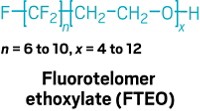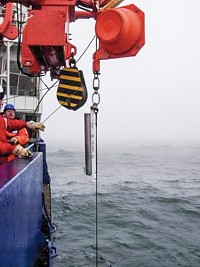Advertisement
Grab your lab coat. Let's get started
Welcome!
Welcome!
Create an account below to get 6 C&EN articles per month, receive newsletters and more - all free.
It seems this is your first time logging in online. Please enter the following information to continue.
As an ACS member you automatically get access to this site. All we need is few more details to create your reading experience.
Not you? Sign in with a different account.
Not you? Sign in with a different account.
ERROR 1
ERROR 1
ERROR 2
ERROR 2
ERROR 2
ERROR 2
ERROR 2
Password and Confirm password must match.
If you have an ACS member number, please enter it here so we can link this account to your membership. (optional)
ERROR 2
ACS values your privacy. By submitting your information, you are gaining access to C&EN and subscribing to our weekly newsletter. We use the information you provide to make your reading experience better, and we will never sell your data to third party members.
Environment
Tracking A Prevalent, Yet Elusive, Family Of Compounds
Pollutants: Researchers find a way to measure volatile molecules used in personal-care products
by Sarah Everts
October 23, 2010

A new technique measures a tricky-to-detect family of molecules that is currently under regulatory scrutiny in Canada, the U.K., and the U.S. for persistence and tendency to bioaccumulate.

The molecules, called cyclic volatile methylsiloxanes (cVMS), find wide use in personal care and cosmetic products because they dry quickly on skin and because they feel silky but not oily.
Every year, human beings release some 30,000 tons of decamethylcyclopentasiloxane (D5), the most commonly used cVMS in personal care products, says Michael McLachlan, an environmental scientist at Stockholm University.
Although a majority of the emissions go into the atmosphere and break down quickly, McLachlan previously found (Environ. Sci. Technol. DOI: 10.1021/es100411w), 10% of human-caused D5 emissions go down the drain when people bathe, with about 1 to 2% slipping past sewage treatment plants. Once in watery environments, the molecules tend to adsorb to sediment, where worms and fish can consume them, he adds.
Assessing the environmental risk of D5 and D4 (octamethylcyclotetrasiloxane), another siloxane sibling present in personal care products, requires measuring the levels of these chemicals in aquatic species. But the characteristics that make these molecules useful in personal care products also make them difficult to measure in animal tissue samples obtained during field studies, McLachlan says.
For example, the molecules evaporate extremely quickly and can easily float away from tissue samples before scientists can measure concentrations. Another challenge is that the molecules exist in a potpourri of products used in everyday life, as well as in silicon-based components of lab equipment. "Sample contamination can be a real problem," says Steve Dungey, a chemicals assessment manager for the U.K. Environment Agency. "For example, it's crucial that scientists in the field don't use deodorant because it contains siloxanes which can contaminate samples."
In addition to avoiding wearing deodorant or using silicone during sampling, McLachlan and his team at Stockholm University developed an experimental procedure for analyzing tissue samples in the lab. The protocol minimizes human handling and sidesteps a common tissue grinding procedure, during which siloxanes in animal flesh can evaporate and contamination can slip in (Anal. Chem., DOI:10.1021/ac102406a). The study was funded by the personal-care giant Unilever.
Instead of grinding up tissue to release the chemicals, the team heats the tissue in a closed system until the meat falls apart and releases gaseous cVMS's, says Amelie Kierkegaard, who is the paper's first author. The molecules then get concentrated in glassware that uses glass wool instead of silicone-based stoppers. The researchers use mass spectrometry to measure levels of cVMS's in the sample.
"This is fantastic work," says Nicholas Warner, an environmental scientist at the Norwegian Institute for Air Research's Polar Environmental Centre, in Tromsø. "It's a good method for getting around background contamination within the laboratory when you don't have access to clean room facilities. The downside is that a large sample apparatus is needed in order to extract many samples at once."
Warner and his colleagues used a clean room to avoid contamination when they performed the first peer-reviewed measurements of cVMS's in the Arctic, published last month (Environ. Sci. Technol., DOI: 10.1021/es101617k). Their study was funded by a European industry group, CES (Centre Européen des Silicones).
Warner's team reported that D5 bioaccumulated in Atlantic cod and another fish, the shorthorn sculpin, near human settlements. Levels were lower in sparsely populated or remote areas. When McLachlan's team measured the D5 concentration in arctic char in several Swedish lakes, they found a similar trend: High concentrations of D5 in Lake Vättern, which has some 200,000 people living close to its watershed, but none of the chemical in three lakes distant from human settlements.
Warner's team also found cVMS's in seal blubber in one set of samples, but in subsequent iterations, levels fell below their field blank levels. Unlike in fish, Warner says, "There seems to be a low risk for cVMS accumulation within mammals. The chemicals are so volatile that the majority of accumulated body burden can be eliminated through breathing."
Earlier this month, policymakers in the U.K. determined that D4 and D5 are "very persistent and very bioaccumulative" in the environment. But no further regulatory action is planned until industry responds, possibly with voluntary restrictions, Dungey says. In 2009, Canadian regulators announced that they may propose a concentration limit for D4 and D5 in products. The Canadian decision is expected in early 2011, after a D5 review board convenes.
In an online position paper, the industry association Silicones Environmental, Health and Safety Council of North America argues that "siloxanes do not pose a risk to human health or the environment."





Join the conversation
Contact the reporter
Submit a Letter to the Editor for publication
Engage with us on Twitter